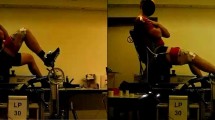Summary
Age dependence of the mechanical behavior of leg extensor muscle was investigated using vertical jumps with and without a stretch-shortening cycle on the force-platform. A total 226 subjects (113 females and 113 males) ranging in age from 4–73 years were examined. The results indicated in general that performance in males was better than that in females. This difference was reduced when body weight was taken into consideration. The peak performance of the various parameters, such as average force, height of rise of center of gravity, net impulse, and also the average power output, was reached in both sexes between the ages of 20 and 30 years. For example, the average vertical force in squatting had the following mean values in the various age groups of the male subjects: 114 N (4–6 years), 402 N (13–17), 618 N (18–28), 508 N (29–40), 435 N (41–49), 320 N (54–65), 315 N (71–73 years). When the jumps were performed using the stretch-shortening cycle, the potential of the mechanical performance after prestretching was also sensitive to aging in a similar manner. The results suggest that it is not only the performance of pure concentric contraction that is influenced by the maturation and aging processes but, the that elastic behavior of muscle and reflex potentiation are also affected by the same processes.
Similar content being viewed by others
References
Asmussen E (1962) Muscular performance. In: Rodahl K, Horvath SM (eds) Muscle as a tissue. McGraw-Hill, New York, pp 161–175
åstrand PO, Rodahl K (1971) Textbook of work physiology. McGraw-Hill, New York
Bosco C, Komi PV (1979a) Potentiation of the mechanical behavior of the human skeletal muscle through prestretching. Acta Physiol Scand 106: 467–472
Bosco C, Komi PV (1976b) Mechanical characteristics and fiber composition of human leg extensor muscles. Eur J Appl Physiol 41: 275–284
Cavagna GA, Citterio G (1974) Effect of stretching on the elastic characteristics and the contractile component of frog striated muscle. J Physiol (Lond) 239: 1–14
Cavagna GA, Dusman B, Margaria R (1968) Positive work done by previously stretched muscle. J Appl Physiol 24: 21–32
Fisher MB, Birren JE (1947) Age and strength. J Appl Physiol 31: 490–497
Hermansen L (1974) The development of work capacity and physical fitness. In: Larsson L (ed) Fitness, health, and work capacity. MacMillan, New York; pp 395–419
Hermansen L, Döbeln W von (1961) Body fat and skinfold measurements. Scand J Clin Lab Invest 27: 316–319
Hettinger TW (1961) Physiology of strength. Thomas Springfield, IL
Komi PV, Bosco C (1978) Utilization of stored elastic energy in man and women. Med Sci Sport 10: 261–265
Komi PV, Karlsson J (1978) Skeletal fibre types, enzyme activities, and physical performance in young males and females. Acta Physiol Scand 103: 210–218
Komi PV, Luhtanen P, Viljamaa K (1974) Measurement of instantaneous contact forces on the force-platform. Research Reports from the Department of Biology of Physical Activity, University of JyvÄskylÄ, Finland (No. 5)
Larsson L, Grimby G, Karlsson J (1979) Muscle strength and speed of contraction in relation to age and muscle morphology. J Appl Physiol 46: 451–456
Larsson L, Sjödin B, Karlsson J (1978) Histochemical and biochemical changes in human skeletal muscle with age in sedentary males, age 22–65 years. Acta Physiol Scand 103: 31–39
Margaria R, Aghemo P, Rovelli E (1966) Measurement of muscular power (anaerobic) in man. J Appl Physiol 21: 1661–1669
Saltin B, Grimby G (1968) Physiological analysis of middle-aged and old former athletes. Circulation 38: 1104–1115
Schmidtbleicher D, Dietz V, Noth J, Antoni M (1978) Auftreten und funktionelle Bedeutung des Muskeldehnungsreflexes bei Lauf- und Sprintbewegungen. Leistungssport 6: 480–490
Shock NW, Norris AH (1970) Neuromuscular coordination as a factor in age changes in muscular exercise. In: Brunner D, Jokl E (eds) Medicine and sport, vol 4; Physical activity and aging. University Park Press, Baltimore, pp 92–99
Author information
Authors and Affiliations
Additional information
Supported in part by a grant No. 8318/78/78 from the Ministry of Education, Finland
Rights and permissions
About this article
Cite this article
Bosco, C., Komi, P.V. Influence of aging on the mechanical behavior of leg extensor muscles. Europ. J. Appl. Physiol. 45, 209–219 (1980). https://doi.org/10.1007/BF00421329
Accepted:
Issue Date:
DOI: https://doi.org/10.1007/BF00421329




